Every pet owner out there wants to take the best possible care of their little pet, whether it’s a guinea pig, a hamster or a dog.
However, it can be really hard to figure out what is most important for the well being of your pet.
That is until today.
It turns out if you follow 8 easy rules when it comes to guinea pig care, chances are…
…. you’ll have a very happy cavy.
In the post today, we’re going to show you exactly how to give your guinea pig the attention it deserves, and we’ve ranked the topics in order of importance.
But first, we’ve made this piggyrific infographic with all the informations condensed.
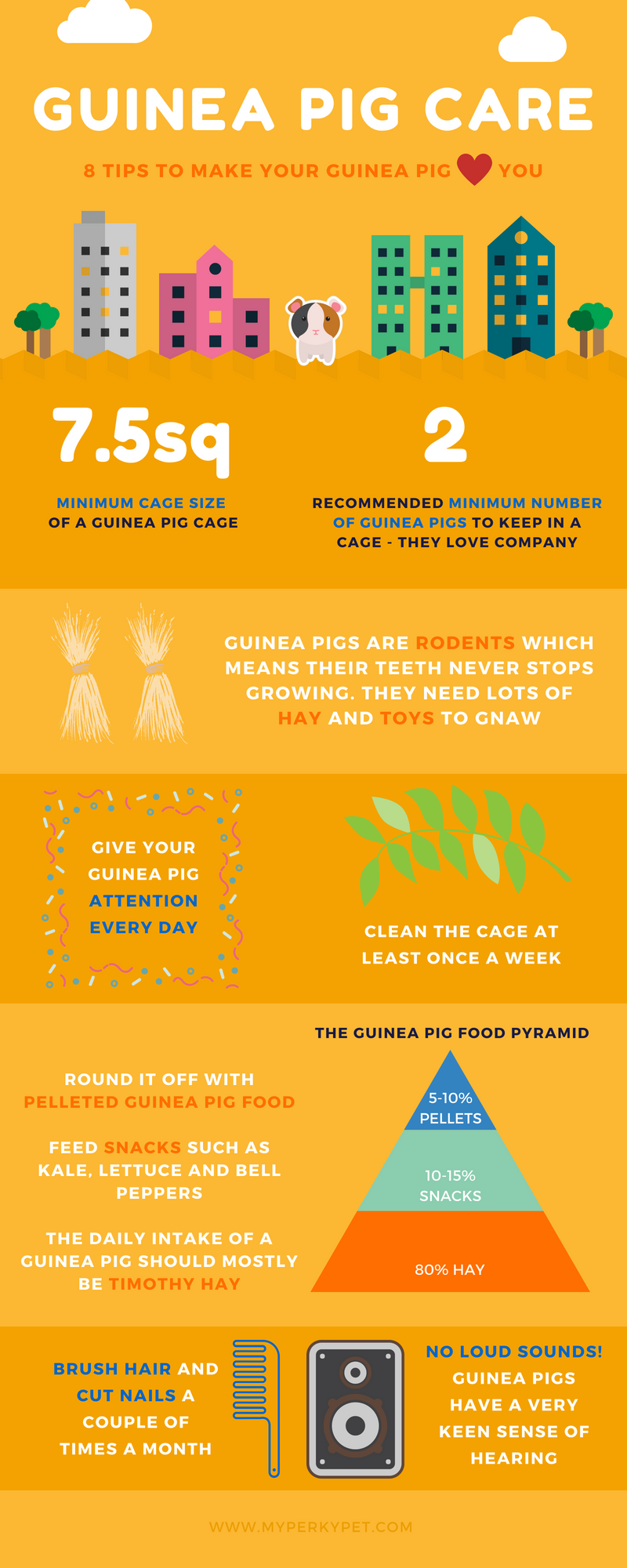
Ready? Let’s get started.
1. A large guinea pig cage
The most important thing when it comes to guinea pig care is having a large cage.
Your little piggy will spend more than 23 hours per day in its cage, so it should come as no surprise that it’s at the top of the list.
However, figuring out what is a good, large cage that’s also safe for you little cavy is a different matter…
… and to make matters worse, many cages marketed as guinea pig cages are either too small or dangerous for your little cavy.
Yes, size matters! Here are the guinea pig cage guidelines
When getting a cage for your guinea pig, size matters. The American Humane Society has the following guidelines for cages:
- One guinea pig: 7.5 square feet cage (minimum), but more is better; generally 30″ x 36″ is a good size.
- Two guinea pigs: 7.5 square feet (minimum), but 10.5 square feet is preferred; generally 30″ x 50″ is a good size.
- Three guinea pigs: 5 square feet (minimum), but 13 square feet is preferred; generally 30″ x 62″ is a good size.
- Four guinea pigs: 13 square feet (minimum), but more is better; generally 30″ x 76″ is a good size.
You can find out more about the best guinea pig cages here, where we review the best guinea pig cages. Here you’ll also find more information about where to keep your guinea pig in the house.
Guinea pigs are not climbers and mainly use one floor to exercise and live in. Thus, if there are extra floors these cannot be added to the ground floor space.
Where to place your guinea pig cage in the house
Based on temperature, humidity and the risk of drafts, we recommend putting your cage inside, preferable in the living room. Here are the reasons why:
- Socializes the guinea pigs
- Is near family activity (which your piggies love)
- Not on the floor – you’ll look like a giant and the piggies will feel every step much more violently. Also this will make even a little poodle look giant to your guinea pig.
- Also, it’s easier to pet the guinea pigs and clean the cage when not on the floor
Things you’ll need in your cavy cage
When you have gotten the large cage (which you cavy will love) it is time to figure out what to put in it. Here’s our checklist:
- Water bottle and holder
- A Food bowl. Ceramic food bowls work the best as they are un-tip-able and un-chewable. You should get one for each piggy you have.
- A house to hide in. These are important as your piggy needs a place where it can sit while feeling secure. Again, you’ll need one house per pig.
- Toys and tunnels
If you are unsure what to get, we have covered accessories and toys here.
Key takeaway:
Get a cage that is at least 7.5 square feet but aim for one that is larger. Place it in your living room.
2. Some company
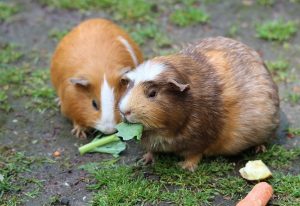 In the wild, guinea pigs live in small herds, usually consisting of one boar and a few females. As a prey animal, they find strength (and security) in numbers, and they still need that security in captivity.
In the wild, guinea pigs live in small herds, usually consisting of one boar and a few females. As a prey animal, they find strength (and security) in numbers, and they still need that security in captivity.
Unfortunately, lone guinea pigs will often become bored no matter the level of human interaction, the level of cuddles and the level of toys. They are also more prone to be picky eaters and develop (annoying) attention seeking behavior.
Also, guinea pigs sleep less than we do, so we cannot give them the attention they deserve.
For these reasons and for both your and your pig’s sake, we strongly recommend housing guinea pigs in pairs.
How can I make sure two guinea pigs will get along?
You can’t! But if done correctly you have a good chance they will. Here are the most important factors:
- Two of everything: You need two houses, two bathrooms, two food bowls and two water bottles. This ensures the piggy can retreat to its own location. And yes, it is also much easier for two piggies to get along than three.
- One sex: Unless you have a neutered boar (or sows), you should have same-sex Females can get pregnant from the age of 4 weeks.
- Different ages: To maximize the chance of a successful pairing it is advisable to get pigs of different ages. Males are very hormonal during the age of 4-14 months and can have fall-outs even if they are a perfectly compatible pair. Having one past the teenage age can help this.
- Monitor your pigs: You should monitor your pigs and their relation closely. But remember, you’re probably more worried than they are. If one pig attacks the other through means such as attack-peeing, tooth chattering or nipping, this is normal herd behavior.
- Separate them for an hour or two: If you’ve seen a fight try separating the two piggies with a wire mesh down the middle of the cage, so they are in their respective “corners”. This allows them to cool down.
What if I already have one guinea pig? Will it get jealous?
If you already have one guinea pig and want to give it some company, one question that is often asked is whether this pig will get jealous.
The answer is luckily no, that is unlikely, so, you should get some companionship for your cavy.
Remember, they are awake more than us humans, so they have a lot of time to kill during the day.
One thing worth remembering is that you potentially need to upgrade your cage if you’re getting a second pig.
Key takeaway:
Get at least two guinea pigs of the same sex. It can be advantageous to get two of different ages as they will not be hormonal (teenagers) at the same time.
3. Something to chew (guinea pig hay, hay, and more hay!)
We’ll start with something not all people know…
Guinea pigs are rodents which means their teeth are always growing.
For that reasons they need two things to keep the teeth in check:
- The most important item in the cage is hay, which the guinea pig should always have access to. The teeth in the back of the mouth of a guinea pig are ground down through the silica in grass and hay. For that reason, hay should make up approximately 80% of the daily food intake. For more on which hay to take, you can check out our guide to guinea pig hay here.
- Toys. In addition to hay, it is a good idea to get toys for your piggies.
What toys to get for your guinea pig
At the pet store, you can get wooden pet toys that your hamster can chew on. In addition to wooden chew toys, cardboard is also great. When using cardboard make sure to use a chemical-free variety.
We do not recommend getting plastic toys for guinea pigs. This is due to the risk of your hamster gnawing plastic loose and digesting it.
Besides the obvious health effect of chewing toys on their teeth, these toys will also provide a fun activity for your guinea pig, which will help keep them happy.
Click here to learn more about guinea pig toys and accessories.
Key takeaway:
Your guinea pig needs hay, hay, and more hay and should always have access to hay. Supplement the hay with toys, so your guinea pig always has something to do.
4. Give your guinea pig exercise and attention every day
Guinea pigs are social animals and will love the attention it receives.
For that matter, it is important to give them attention every day as well as allowing them to exercise outside their cage.
Here are some things to have in mind:
- Let your guinea pig loose in an enclosed area. A playpen works great and can be used both inside and outside (provided it is between 65-80 degrees)
- If you let it loose outside be sure to monitor it very carefully. Guinea pigs are very small and can easily squeeze through small openings
- Put a few toys and tunnels in the designated play area
How to make playtime engaging for both guinea pig and owner
When letting your guinea pig out of its cage, you can be much more than just an observer.
Here are some of the things you can do to make sure you have as much fun as your little piggy:
- Teach your guinea pig tricks. Yes, guinea pigs are actually quite smart and can be taught a variety of tricks. You do so by a combination of gesture and sound while rewarding your guinea pig when it does the trick. It is thus very similar to training dogs. Some tricks include standing on hind legs, spinning and jumping.
- Cuddle the pig. Guinea pigs like to be handled and cuddled with (provided you have a bond) and they’ll enjoy being carried as well.
How to handle your guinea pig
Picking up your guinea pig is relatively easy and intuitive to do and here’s how.
- Pick it up carefully to avoid any injury or discomfort
- Use one hand for support under the chest, while the other hand is used for support under the hindquarters
- Never grab over its back, as doing so can inhibit his breathing
- And be attentive – it is a small pet which can easily be dropped
Key takeaway:
Make sure to interact with your guinea pig each day and let it out of its cage. It will love the attention and your bond will become stronger.
5. A clean cage
Guinea pigs are clean animals by nature and will do a lot of the cleaning work themselves. However, they can’t do it all so as a guinea pig owner, there are two things you need to take care of:
Once per day: You should remove the poops from the cage every day. They are easy to spot and easy to remove.
Once per week: One time every week you should remove the bedding from the cage, clean the cage and put in new bedding. If your cage starts getting smelly (likely from pee) before that consider changing your bedding. Good guinea pig bedding should last a week without emitting odors.
While cleaning the cage, be sure to exercise your piggies as it is a natural time for your piggies to get some time outside of their cage.
Key takeaway:
Remove poops once per day and clean the cage once per week.
6. No hamster food! Feed proper guinea pig food every day
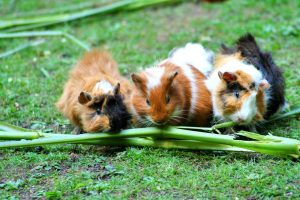 Why do I need to feed my guinea pig every day?
Why do I need to feed my guinea pig every day?
Let’s start by asking a question: If you had a cat or a dog would you feed it every day?
You would, of course, feed it every day, and the same goes for your little piggy – the fact it is smaller and lives in a cage doesn’t change that.
This will also lead to another advantage: You’ll be able to monitor the intake of your piggies.
If one suddenly stops eating or drinking this is a potential sign of a disease and if it happens, we recommend seeing a vet.
What to feed your guinea pig
As already mentioned, about 80% of your piggies diet should be timothy hay. Here is the full breakdown of the recommended daily diet for your pig:
- Approximately 80% timothy hay
- 10-15% snacks such as vegetables and fresh herbs. Shoot for the equivalent of 1 cup-full, which will weigh ~2oz (50 grams)
- 5-10% pellets of guinea pig food. One eight of a cup or a little less than an ounce is all they need. If they are fast growing pigs up to the age of 4-6 months, you can double this ratio.
Keeping a fresh diet
When giving your guinea pigs treats (they’ll spoil quickly) you need to be conscientious about removing uneaten fruits, veggies, and other perishable foods. Ideally, you should check for untouched or unfinished treats an hour after having offered these to your pig.
As for the pellets, these should be replaced on a daily basis. Guinea pigs often kick bedding material or droppings into their food bowls, and stale pellets will have little if any, Vitamin C left in them.
If there are many pellets left in the food bowl every day, you’re probably giving your pig too much. An eighth of a cup is all that’s needed.
How do I know if I am over/under feeding my guinea pig?
First off, the ideal weight for 75% of guinea pigs is between 40-50 oz (1,000-1,200g).
However, if your pig is not within this range it might be natural, as weight is only one thing to monitor.
The best way is instead to feel the heft of the pig. Here are the guidelines:
- A healthy piggy should have a ribcage that can be felt, but where not every single rib is standing out
- If you can’t feel any ribs at all, then your piggy is most likely overweight. Try reducing the pellet intake and/or cut down on treats – especially fruits which has more sugar
- On the other side, if every single rib is standing out your piggy is likely underweight and you should increase its diet of pellets and/or snacks
The heft is a better indicator of health than body shape. Especially the female pigs often have a behind that can become quite large without them being overweight.
Key takeaway:
Feed your guinea pig a balanced diet of 80% hay, 10-15% vegetables and fruits, and 5-10% pelleted food. In addition, give it fresh water every day.
7. Brush their hair and cut their toenails
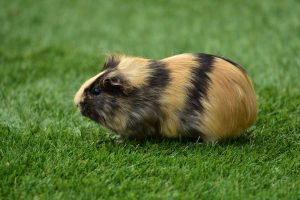 It is a good idea to brush the hairs of your guinea pigs regularly. For shorter-haired guinea pigs this lessens shredding and for longer haired guinea pigs it is a necessity, as their hair can otherwise become entangled.
It is a good idea to brush the hairs of your guinea pigs regularly. For shorter-haired guinea pigs this lessens shredding and for longer haired guinea pigs it is a necessity, as their hair can otherwise become entangled.
For long-haired guinea pigs, you should brush them at least twice per month, to ensure their hair doesn’t become entangled.
You can see some good guinea pig brushes here.
In addition to brushing the fur of the guinea pigs, you also need to cut their toenails. This should also be done twice per month and is a little bit more daunting to do the first couple of times – if you do it wrong, the guinea pig can start bleeding.
So, here’s how to cut the toe-nails of a guinea pig:
- Make sure you have a proper guinea pig nail trimmer that is suited to how their nails grow
- Pick up your guinea pig
- For each nail, identify where the quick is. The quick is where the blood vessels and nerve ending are and if you cut into this, the pig will start bleeding
- If your guinea pig has clear nails, the quick will be the visible pink part. If it has darkly colored nails, shine a light behind it, so you can see the different shades of the nail.
- Place the guinea pig on your lap with its stomach facing out
- Hold one leg gently and start to trim each nail before moving on to the next leg
Key takeaways:
About twice per month, make your own pet salon where you brush the hair and clip the nails of your guinea pigs.
8. Aww, my ears. No loud sounds near your guinea pig
Guinea pigs are (small) prey animals living in areas of the world with high grass – areas where the hearing sense is worth more than your sight.
For that reason, it is not surprising they have developed a very keen sense of hearing.
Due to their keen sense of hearing, any sudden loud sounds are basically the equivalent of a human being exposed to two metal objects being slammed together.
It is fine having the guinea pig in your living room with the occasional movie sounds from the tv, but if you have people in your family who tend to shout at the TV during sports, consider whether you should give your piggy some playtime somewhere else during the game.
Key takeaway:
The guinea pig has a very keen sense of hearing so avoid loud and sudden sounds where it lives.
Are you ready to be a guinea pig owner?
There are many joys to owning guinea pigs, but as you can see it also takes some time and attention, somewhat more than a hamster and less than a dog.
However, there is no magic to being a guinea pig owner and if you follow the eight rules above, chances are you’ll have a great relationship with your small, adorable pets.
If you have any questions please don’t hesitate in leaving a comment below – we’ll be around to answer them.


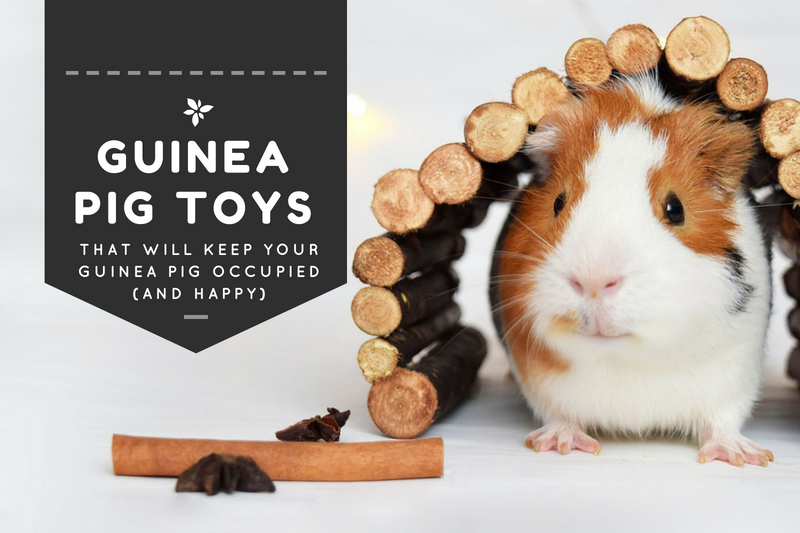
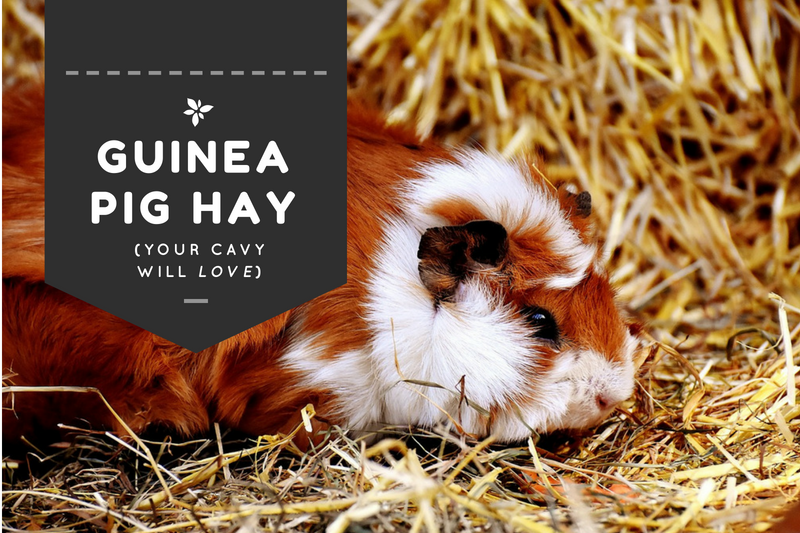
Should I gravitate to a male or female guinea pig? Or does it matter? It will be the only one, at least for the near future.
The infographic was really great, I finally found out how much ratio of food types I should give to my guinea pig pets.
Great article! 👍
Great share! This is worth sharing for guinea pig owners!